[English] 日本語
 Yorodumi
Yorodumi- PDB-1opp: PEPTIDE OF HUMAN APOLIPOPROTEIN C-I RESIDUES 1-38, NMR, 28 STRUCTURES -
+ Open data
Open data
- Basic information
Basic information
| Entry | Database: PDB / ID: 1opp | ||||||
|---|---|---|---|---|---|---|---|
| Title | PEPTIDE OF HUMAN APOLIPOPROTEIN C-I RESIDUES 1-38, NMR, 28 STRUCTURES | ||||||
 Components Components | APOLIPOPROTEIN C-I | ||||||
 Keywords Keywords |  APOLIPOPROTEIN / AMPHIPATHIC HELIX / LIPID ASSOCIATION / LCAT ACTIVATION APOLIPOPROTEIN / AMPHIPATHIC HELIX / LIPID ASSOCIATION / LCAT ACTIVATION | ||||||
| Function / homology |  Function and homology information Function and homology informationnegative regulation of phosphatidylcholine catabolic process / VLDL clearance / negative regulation of very-low-density lipoprotein particle clearance /  VLDL assembly / lipase inhibitor activity / negative regulation of cholesterol transport / negative regulation of lipoprotein lipase activity / phospholipase inhibitor activity / plasma lipoprotein particle remodeling / regulation of cholesterol transport ...negative regulation of phosphatidylcholine catabolic process / VLDL clearance / negative regulation of very-low-density lipoprotein particle clearance / VLDL assembly / lipase inhibitor activity / negative regulation of cholesterol transport / negative regulation of lipoprotein lipase activity / phospholipase inhibitor activity / plasma lipoprotein particle remodeling / regulation of cholesterol transport ...negative regulation of phosphatidylcholine catabolic process / VLDL clearance / negative regulation of very-low-density lipoprotein particle clearance /  VLDL assembly / lipase inhibitor activity / negative regulation of cholesterol transport / negative regulation of lipoprotein lipase activity / phospholipase inhibitor activity / plasma lipoprotein particle remodeling / regulation of cholesterol transport / very-low-density lipoprotein particle assembly / negative regulation of lipid metabolic process / negative regulation of receptor-mediated endocytosis / chylomicron remnant clearance / very-low-density lipoprotein particle clearance / negative regulation of fatty acid biosynthetic process / phosphatidylcholine-sterol O-acyltransferase activator activity / VLDL assembly / lipase inhibitor activity / negative regulation of cholesterol transport / negative regulation of lipoprotein lipase activity / phospholipase inhibitor activity / plasma lipoprotein particle remodeling / regulation of cholesterol transport / very-low-density lipoprotein particle assembly / negative regulation of lipid metabolic process / negative regulation of receptor-mediated endocytosis / chylomicron remnant clearance / very-low-density lipoprotein particle clearance / negative regulation of fatty acid biosynthetic process / phosphatidylcholine-sterol O-acyltransferase activator activity /  chylomicron / lipoprotein metabolic process / high-density lipoprotein particle remodeling / chylomicron / lipoprotein metabolic process / high-density lipoprotein particle remodeling /  phosphatidylcholine binding / phospholipid efflux / very-low-density lipoprotein particle / high-density lipoprotein particle / cholesterol efflux / triglyceride metabolic process / negative regulation of lipid catabolic process / NR1H3 & NR1H2 regulate gene expression linked to cholesterol transport and efflux / cholesterol metabolic process / phosphatidylcholine binding / phospholipid efflux / very-low-density lipoprotein particle / high-density lipoprotein particle / cholesterol efflux / triglyceride metabolic process / negative regulation of lipid catabolic process / NR1H3 & NR1H2 regulate gene expression linked to cholesterol transport and efflux / cholesterol metabolic process /  fatty acid binding / lipid metabolic process / fatty acid binding / lipid metabolic process /  endoplasmic reticulum / extracellular region endoplasmic reticulum / extracellular regionSimilarity search - Function | ||||||
| Biological species |   Homo sapiens (human) Homo sapiens (human) | ||||||
| Method |  SOLUTION NMR / DISTANCE GEOMETRY, SOLUTION NMR / DISTANCE GEOMETRY,  SIMULATED ANNEALING SIMULATED ANNEALING | ||||||
 Authors Authors | Rozek, A. / Buchko, G.W. / Kanda, P. / Cushley, R.J. | ||||||
 Citation Citation |  Journal: Protein Sci. / Year: 1997 Journal: Protein Sci. / Year: 1997Title: Conformational studies of the N-terminal lipid-associating domain of human apolipoprotein C-I by CD and 1H NMR spectroscopy. Authors: Rozek, A. / Buchko, G.W. / Kanda, P. / Cushley, R.J. | ||||||
| History |
|
- Structure visualization
Structure visualization
| Structure viewer | Molecule:  Molmil Molmil Jmol/JSmol Jmol/JSmol |
|---|
- Downloads & links
Downloads & links
- Download
Download
| PDBx/mmCIF format |  1opp.cif.gz 1opp.cif.gz | 336.6 KB | Display |  PDBx/mmCIF format PDBx/mmCIF format |
|---|---|---|---|---|
| PDB format |  pdb1opp.ent.gz pdb1opp.ent.gz | 278 KB | Display |  PDB format PDB format |
| PDBx/mmJSON format |  1opp.json.gz 1opp.json.gz | Tree view |  PDBx/mmJSON format PDBx/mmJSON format | |
| Others |  Other downloads Other downloads |
-Validation report
| Arichive directory |  https://data.pdbj.org/pub/pdb/validation_reports/op/1opp https://data.pdbj.org/pub/pdb/validation_reports/op/1opp ftp://data.pdbj.org/pub/pdb/validation_reports/op/1opp ftp://data.pdbj.org/pub/pdb/validation_reports/op/1opp | HTTPS FTP |
|---|
-Related structure data
| Similar structure data |
|---|
- Links
Links
- Assembly
Assembly
| Deposited unit | 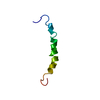
| |||||||||
|---|---|---|---|---|---|---|---|---|---|---|
| 1 |
| |||||||||
| NMR ensembles |
|
- Components
Components
| #1: Protein/peptide |  / APO-CI / APO-CIMass: 4256.853 Da / Num. of mol.: 1 / Fragment: RESIDUES 1 - 38 / Source method: obtained synthetically Details: synthesized using standard Fmoc-based solid-phase protocols Source: (synth.)   Homo sapiens (human) / References: UniProt: P02654 Homo sapiens (human) / References: UniProt: P02654 |
|---|
-Experimental details
-Experiment
| Experiment | Method:  SOLUTION NMR SOLUTION NMR | ||||||||||||||||||||||||||||
|---|---|---|---|---|---|---|---|---|---|---|---|---|---|---|---|---|---|---|---|---|---|---|---|---|---|---|---|---|---|
| NMR experiment |
|
- Sample preparation
Sample preparation
| Details |
| ||||||||||||||||||||||||||||||||
|---|---|---|---|---|---|---|---|---|---|---|---|---|---|---|---|---|---|---|---|---|---|---|---|---|---|---|---|---|---|---|---|---|---|
| Sample |
| ||||||||||||||||||||||||||||||||
| Sample conditions | pH: 4.8 / Temperature: 310 K | ||||||||||||||||||||||||||||||||
Crystal grow | *PLUS Method: other / Details: NMR |
-NMR measurement
| NMR spectrometer | Type: Bruker AMX 600 / Manufacturer: Bruker / Model : AMX 600 / Field strength: 600 MHz : AMX 600 / Field strength: 600 MHz |
|---|
- Processing
Processing
| NMR software |
| |||||||||
|---|---|---|---|---|---|---|---|---|---|---|
| Refinement | Method: DISTANCE GEOMETRY,  SIMULATED ANNEALING / Software ordinal: 1 SIMULATED ANNEALING / Software ordinal: 1 Details: THE STRUCTURE OF APOC-I(1-38) IN THE PRESENCE OF SODIUM DODECYL SULFATE WAS REFINED USING 464 NOE-BASED DISTANCE RESTRAINTS. NO DIHEDRAL RESTRAINTS WERE USED. THIS ENTRY CONTAINS ALL 28 ...Details: THE STRUCTURE OF APOC-I(1-38) IN THE PRESENCE OF SODIUM DODECYL SULFATE WAS REFINED USING 464 NOE-BASED DISTANCE RESTRAINTS. NO DIHEDRAL RESTRAINTS WERE USED. THIS ENTRY CONTAINS ALL 28 ACCEPTED STRUCTURES. STRUCTURE CALCULATIONS WERE PERFORMED WITH THE PROGRAM DGII (BIOSYM/MSI, SAN DIEGO, CA) INCLUDING DISTANCE GEOMETRY CALCULATIONS, SIMULATED ANNEALING AND ENERGY MINIMIZATION WITH A CONJUGATED GRADIENT. THE CVFF FORCE FIELD WAS USED. FOR DETAILS ON STRUCTURE CALCULATION AND RMSDS PLEASE SEE REFERENCE CITED ON JRNL RECORDS ABOVE. | |||||||||
| NMR ensemble | Conformer selection criteria: structures with the least restraint violations Conformers calculated total number: 30 / Conformers submitted total number: 28 |
 Movie
Movie Controller
Controller




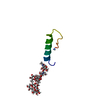
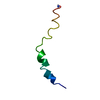
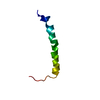
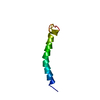
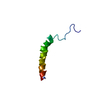
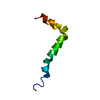

 PDBj
PDBj


